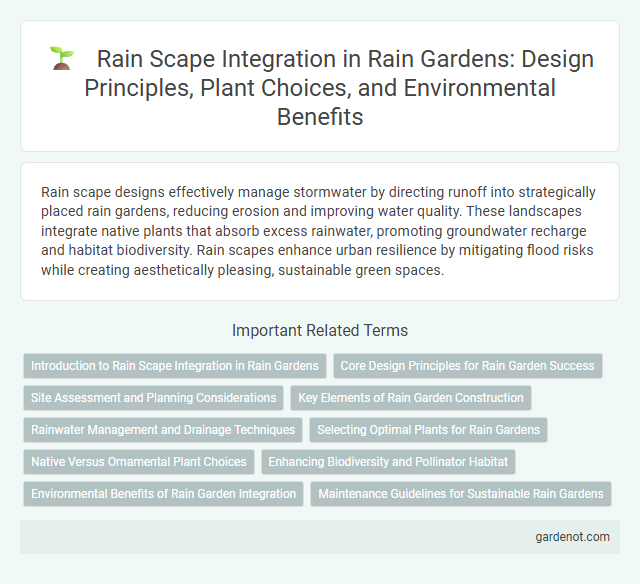Rain scape designs effectively manage stormwater by directing runoff into strategically placed rain gardens, reducing erosion and improving water quality. These landscapes integrate native plants that absorb excess rainwater, promoting groundwater recharge and habitat biodiversity. Rain scapes enhance urban resilience by mitigating flood risks while creating aesthetically pleasing, sustainable green spaces.
Introduction to Rain Scape Integration in Rain Gardens
Rain scape integration in rain gardens enhances stormwater management by mimicking natural hydrological processes to capture, filter, and slowly release runoff. Incorporating rain scape design elements like permeable surfaces, native vegetation, and rainwater harvesting systems increases water infiltration and reduces urban flooding. Optimizing rain scape techniques supports biodiversity, improves water quality, and promotes sustainable landscape practices.
Core Design Principles for Rain Garden Success
Rain scape design emphasizes core principles such as proper site assessment, soil permeability, and selecting native vegetation to enhance infiltration and reduce runoff. Effective rain gardens incorporate layered soil media and strategically placed plants to optimize water absorption and filtration. Consistent maintenance and monitoring ensure long-term performance and ecological benefits.
Site Assessment and Planning Considerations
Site assessment for rain gardens involves analyzing soil permeability, slope, and drainage patterns to ensure optimal water infiltration and prevent flooding. Planning considerations include selecting native, drought-tolerant plants adapted to local climate and managing runoff from impervious surfaces such as roofs and driveways. Proper evaluation minimizes erosion risks and enhances the rain garden's ability to improve water quality and support local biodiversity.
Key Elements of Rain Garden Construction
Rain garden construction centers on key elements such as proper site selection, soil permeability, and native plant species to maximize water absorption and filtration. Incorporating an inlet for directing runoff, a basin designed to temporarily hold stormwater, and an outlet for overflow ensures effective water management and prevents erosion. Mulch and vegetation layers stabilize the garden, enhance pollutant removal, and support local biodiversity within the rainscape.
Rainwater Management and Drainage Techniques
Rain scape designs integrate advanced rainwater management and drainage techniques to reduce runoff and promote groundwater recharge. Incorporating permeable surfaces, bioswales, and strategically placed rain gardens enhances infiltration and minimizes urban flooding risks. Effective rainwater capture and filtration in rain scapes improve water quality and support sustainable landscape practices.
Selecting Optimal Plants for Rain Gardens
Selecting optimal plants for rain gardens involves prioritizing native species that tolerate both wet and dry conditions, ensuring effective water absorption and soil stabilization. Deep-rooted perennials such as switchgrass, blue flag iris, and Joe-Pye weed enhance infiltration and prevent erosion in rain scapes. Choosing a diverse mix of moisture-adapted plants improves pollutant filtration and supports local biodiversity within rain gardens.
Native Versus Ornamental Plant Choices
Selecting native plants for rain gardens enhances local biodiversity, improves soil absorption, and supports pollinators compared to ornamental species. Native plants, adapted to regional climate and soil conditions, require less maintenance, water, and fertilizer, ensuring sustainable rainwater management. Ornamental plants, while visually appealing, may lack ecological benefits and can sometimes become invasive, disrupting local ecosystems.
Enhancing Biodiversity and Pollinator Habitat
Rain gardens incorporated in rainscape designs significantly enhance biodiversity by creating diverse microhabitats that support native plants and wildlife. These gardens provide essential forage and nesting sites for pollinators such as bees, butterflies, and hummingbirds, contributing to the preservation of local ecosystems. Implementing rain gardens in urban and suburban environments also improves habitat connectivity, fostering resilient pollinator populations and promoting ecological balance.
Environmental Benefits of Rain Garden Integration
Rain gardens significantly reduce stormwater runoff by capturing and infiltrating rainwater, which decreases pollution in local waterways and mitigates urban flooding. They promote groundwater recharge and support biodiversity by providing habitat for native plants and pollinators. Integrating rain gardens into urban landscapes enhances air quality and reduces the heat island effect, contributing to a healthier environment.
Maintenance Guidelines for Sustainable Rain Gardens
Proper maintenance of rain gardens ensures their long-term sustainability by promoting healthy plant growth and efficient water absorption. Regular tasks include removing weeds, inspecting inlet and outlet structures for blockages, and replenishing mulch to maintain soil moisture and prevent erosion. Monitoring plant health and replacing dead or invasive species supports optimal filtration and enhances stormwater management performance.
Rain scape Infographic

 gardenot.com
gardenot.com